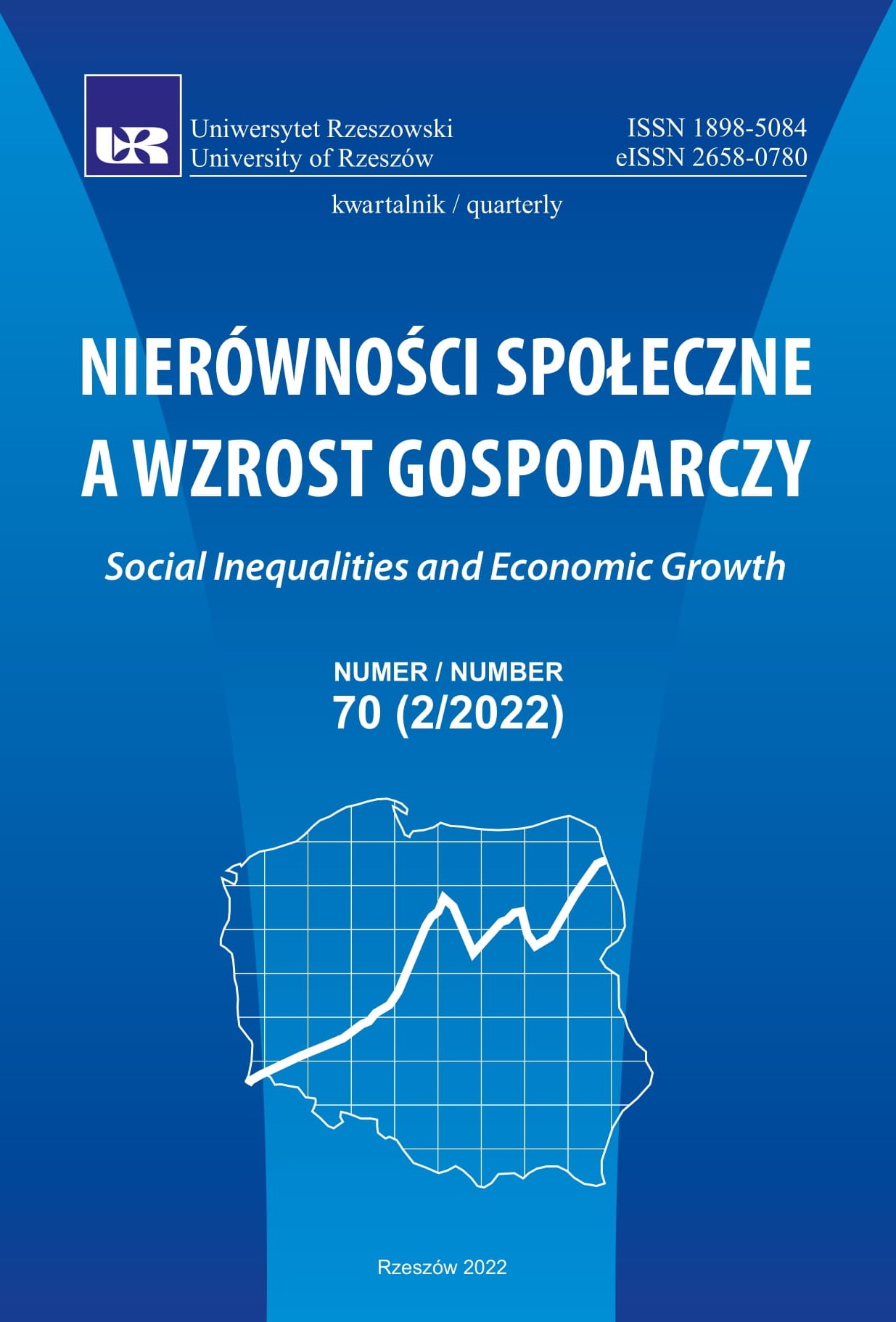Cluster structure as an example of an international business model
DOI:
https://doi.org/10.15584/nsawg.2022.2.6Keywords:
cluster, integration processes, internationalisation, international businessAbstract
In global conditions, clusters are obliged to operate on the international market to a greater extent than ever. Due to the evolution of the economic environment, these structures, and in particular their entities-members, wanting to increase their competitiveness and develop, take actions on global markets, and engage in international cooperation. Hence, their support towards internationalisation, which determines their functioning and success in the market, is of great importance. That is why the offer of activities supporting this process, both at the EU and national level, is so important. This support should apply in particular to Key National Clusters, which are of exceptional importance for the country and the regions in which they operate.
The aim of the article is an attempt to show the essence and function of the cluster structure, which is an example of a business model. In the following parts of the study, attempts were made to introduce the concept and classification of business models and the concept of the international cluster model. The advantages of the internationalisation of cluster structures are presented, as well as the sources of financing and forms of support for this process. Examples of key cluster structures in Poland were presented, as well as the “Aviation Valley” Cluster as a case study. In order to show the role of clusters in increasing efficiency, innovation and competitiveness, the results of our own research were used. They were carried out in 2015 among 80 entrepreneurs participants of four agri-food clusters, as well as among 4 representatives of institutions managing these clusters in the Podkarpackie Voivodeship. The study puts forward the thesis that properly functioning cluster structures contribute to an increase in the level of innovation in the economy and the competitiveness of entities, eliminating the inequalities in their development, both at the local, regional and international levels.
Downloads
References
Adamczuk, F. (2014). Identyfikacja modelu klastra oraz etapu jego rozwoju na przykładzie klastra Ceramika i Turystyka. Prace Naukowe Uniwersytetu Ekonomicznego we Wrocławiu, 369, 11–24.
Banaszyk, P. (2006). Znaczenie modelu biznesu w strategicznej odnowie przedsiębiorstwa. W: K. Zieniewicz (red.), Instrumenty zarządzania we współczesnym przedsiębiorstwie. Analiza krytyczna (s. 38–44). Poznań: Wyd. Akademii Ekonomicznej w Poznaniu.
Chorób, R. (2013). Koopetycja w innowacyjnych strukturach integracyjnych. Zarządzanie i Finanse („Journal of Management and Finance”), 11(1), Część 1, 83–92.
Chorób, R. (2015). Strengths functioning cluster structures prerequisite for innovation and competitiveness of the economy. Scientific Journal, High-Economic Social School in Ostroleka, 4(19), 74–82.
Chorób, R. (2017). Uwarunkowania rozwoju innowacyjnych form powiązań integracyjnych rolnictwa z przemysłem spożywczym z uwzględnieniem klastrów rolno-spożywczych (na przykładzie województwa podkarpackiego). Rzeszów: Wyd. Uniwersytetu Rzeszowskiego.
Czart, P. (2019). Pojęcie modelu biznesu – analiza bibliometryczna. ZN WSH Zarządzanie, 2, 173–191. DOI: 10.5604/01.3001.0013.5223.
Dolina Lotnicza, http://www.dolinalotnicza.pl/o-nas/ (2021.12.06).
Goliński, M. (2018). Gospodarka cyfrowa, gospodarka informacyjna, gospodarka oparta na wiedzy – różne określenia tych samych zjawisk czy podobne pojęcia określające różne zjawiska? Roczniki Kolegium Analiz Ekonomicznych, 49, 177–190.
Haberla, M. (2018). Internacjonalizacja klastrów. Handel Wewnętrzny, 5(376), 112–121. Internacjonalizacja klastrów, red. B. Greenhalgh (2014). Warszawa: PARP.
Islankina, E. (2015). Internationalization of Regional Clusters: Theoretical and Empirical Issues (June 26, 2015). Higher School of Economics Research Paper, No. WP BRP 41/STI/2015. DOI: 10.2139/ssrn.2623532.
Krajowe Klastry Kluczowe, https://www.gov.pl/web/rozwoj-technologia/krajowe-klastry--kluczowe (2021.12.06).
Nogalski, B. (2009). Modele biznesu jako narzędzia reorientacji strategicznej przedsiębiorstw. Master of Business Administration, 17(2), 3–14.
Osterwalder, A., Pigneur, Y., Tucci, L. (2005). Claryfaing Business Models: Origins, Present and Future of the Concept. Communications of the Association for Information Systems, 16, 1–25. DOI: 10.17705/1CAIS.01601.
Polski Przemysł – Portal Przemysłowy: Dolina Lotnicza – polski przykład centrum biznesu na światową skalę, https://polskiprzemysl.com.pl/przemysl-lotniczy/dolina-lotnicza-klaster-lotniczy/ (2021.12.06).
Porter, M.E. (2001). Porter o konkurencji. Warszawa: PWE.
Rosińska-Bukowska, M. (2012). Istota transferu wiedzy i kreacji innowacji w klastrach – analiza inicjatyw klastrowych w regionie łódzkim. Zeszyty Naukowe Uniwersytetu Szczecińskiego. Ekonomiczne Problemy Usług, 94, 245–262.
Rymarczyk, J. (2012). Biznes międzynarodowy. Warszawa: PWE.
Rymarczyk, J. (2017). Modele biznesu międzynarodowego. W: M. Maciejewski, K. Wach (red.), Handel zagraniczny i biznes międzynarodowy we współczesnej gospodarce (s. 143–158). Kraków: Uniwersytet Ekonomiczny w Krakowie.
Sarama, M., Chorób, R. (2021). Społeczne i ekonomiczne aspekty transformacji cyfrowej w Polsce. Rzeszów: Wyd. Uniwersytetu Rzeszowskiego.
Teece, D.J. (2010). Models, Business Strategy and Innovation. Long Range Planning, 43, 172–194. DOI: 10.1016/j.lrp.2009.07.003.
Downloads
Published
How to Cite
Issue
Section
License

This work is licensed under a Creative Commons Attribution-ShareAlike 4.0 International License.


